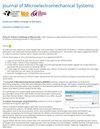Frequency Split Modulation in Micro Hemispherical Resonator Based on Rim Width
IF 3.1
3区 工程技术
Q2 ENGINEERING, ELECTRICAL & ELECTRONIC
引用次数: 0
Abstract
The micro hemispherical resonator is center-symmetric, and the mass and stiffness of the resonator are completely coupled. In instances where manufacturing errors are present, both mass perturbations and stiffness perturbations are introduced concurrently, leading to frequency split. Given that the formation errors of micro hemispherical resonator, specifically mass and stiffness disturbances, are predominantly concentrated in the shell, this paper proposes a micro hemispherical resonator with adjustable rim width, whose rim area is distributed circumferentially around the shell periphery. An equivalent geometric model of the resonator was established, and finite element simulation was used to study the influence of rim width on the frequency split of the resonator under different harmonic errors. It was determined that within a specified error range, adjusting the rim width results in a minimum value for the frequency split. To validate the effectiveness of the simulation results, the rim width was altered using femtosecond laser direct etching, and the resonant frequencies were measured at different rim widths. The experimental findings demonstrated that the frequency split of the resonator attained a minimum at a rim width of 0.7 mm, with a frequency split of only 1.09 Hz (86.44 ppm), which was 8.4 times lower than that at a rim width of 0 mm. Consequently, the method delineated in this paper can effectively mitigate the frequency split of resonator in circumstances where manufacturing errors are unavoidable, thereby significantly reducing the threshold for electrostatic trimming and offering the potential to achieve approximate frequency matching from a structural design perspective.[2025-0088]基于边缘宽度的微半球谐振器分频调制
微半球形谐振腔是中心对称的,谐振腔的质量和刚度是完全耦合的。在存在制造误差的情况下,同时引入质量摄动和刚度摄动,导致频率分裂。考虑到微半球谐振器的形成误差,特别是质量和刚度扰动主要集中在壳体内,本文提出了一种边缘宽度可调的微半球谐振器,其边缘面积沿壳体外围圆周分布。建立了谐振腔的等效几何模型,采用有限元仿真方法研究了在不同谐波误差下,边缘宽度对谐振腔分频的影响。确定在指定的误差范围内,调整边缘宽度导致频率分裂的最小值。为了验证仿真结果的有效性,采用飞秒激光直接刻蚀法改变了边缘宽度,并测量了不同边缘宽度下的谐振频率。实验结果表明,谐振腔的分频在环宽为0.7 mm时达到最小,分频仅为1.09 Hz (86.44 ppm),比环宽为0 mm时的分频低8.4倍。因此,本文描述的方法可以在制造误差不可避免的情况下有效地减轻谐振器的频率分裂,从而显着降低静电修整的阈值,并从结构设计的角度提供实现近似频率匹配的潜力。[2025-0088]
本文章由计算机程序翻译,如有差异,请以英文原文为准。
求助全文
约1分钟内获得全文
求助全文
来源期刊

Journal of Microelectromechanical Systems
工程技术-工程:电子与电气
CiteScore
6.20
自引率
7.40%
发文量
115
审稿时长
7.5 months
期刊介绍:
The topics of interest include, but are not limited to: devices ranging in size from microns to millimeters, IC-compatible fabrication techniques, other fabrication techniques, measurement of micro phenomena, theoretical results, new materials and designs, micro actuators, micro robots, micro batteries, bearings, wear, reliability, electrical interconnections, micro telemanipulation, and standards appropriate to MEMS. Application examples and application oriented devices in fluidics, optics, bio-medical engineering, etc., are also of central interest.
 求助内容:
求助内容: 应助结果提醒方式:
应助结果提醒方式:


